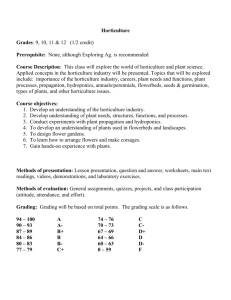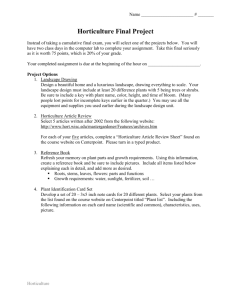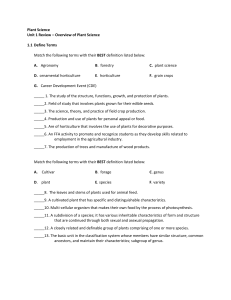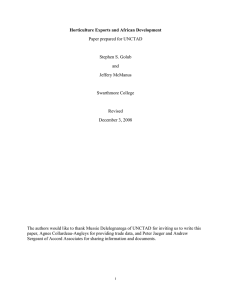UNCTAD Secretary-General's High-Level Multi-Stakeholder Dialogue on Commodities
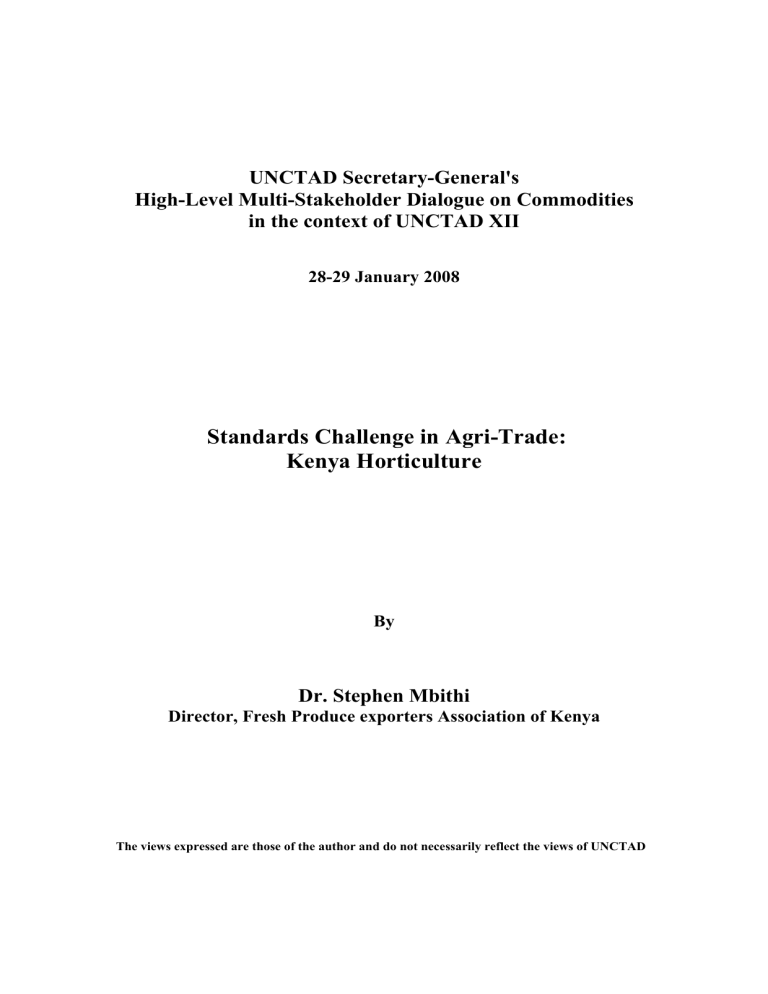
UNCTAD Secretary-General's
High-Level Multi-Stakeholder Dialogue on Commodities in the context of UNCTAD XII
28-29 January 2008
Standards Challenge in Agri-Trade:
Kenya Horticulture
By
Dr. Stephen Mbithi
Director, Fresh Produce exporters Association of Kenya
The views expressed are those of the author and do not necessarily reflect the views of UNCTAD
Standards Challenge in Agri-Trade:
Kenya Horticulture
Dr Stephen Mbithi:
Fresh Produce exporters Association of Kenya
(FPEAK)
E-mail: info@fpeak.org
Tel +254722716956
Presentation at UNCTAD Geneva [28-29Jan 2008]
Kenyan Horticulture at a Glance
{
{
{
An emerging export sector:
{
{
Traditional agriculture comprises of coffee and tea
Veg, fruits flowers export is about 30yrs old
About 250,000MT volume, z
700mil US$ (2006) -14% growth, 1bn US$ in 2007-
30% growth
{
Flowers about 60% value, fruits and veges 40% value
{
Highest growth in small to medium scale production (1-
10 acres crop)
Sector:
{
{
500,000 growers, 240 exporters, about 1.5 million people directly employed and 4.5 million directly or indirectly dependent on horticulture
90% production is traded domestically,
Small Scale – The Way to Go?
z z
About 80% of both producers and exporters are small scale.
{
Small scale growers -40% of export volume of veges, and about 20% of flower exports
A growth sub-sector – land holdings in high potential areas average 2.5 acres
{
{
{
Logistical nightmare to find huge tracts of land for large scale horticulture z
May be good from a social equity point
Commodity crops such as cereals, are low value
(families cant pay school fees or pay medical bills on that)
High value crops the way to go, but…..STANDARDS
Large-Small scale – a symbiosis?
z
Bulking- key to small scale participation in export trade
{
{
{
{
{
{
Standards – a rallying call?
Many small = large scale OR many Small
Large Scale
Guided production: area-specific economies of scale
Choosing the stop-point - level of value chain
(with 240 exporters, the market and price is not secret anymore.
Exporter groups vs middlemen –
Contract farming? Fair price as a regulator
Horticulture: Facilitating Institutions
{
{
{
Industry Associations z
Facilitating small-large scale linkages, promotions, policy interface, running joint projects (FPEAK, KFC,KHC)
Standards Inspectorate z
Official control systems, certification for exports, official linkages with importing states
{
Kenya Plant Health Inspectorate Services
(KePHIS)
Central Govt, Horticulture Parastatal z
HCDA, KeBS etc
Standards: The Types
{
Types
z z
Sanitary and Phytosanitary Standards
(SPS)
{
Sanitary –Basically HACCP
{
Phytosanitary
Fair Trade/Labor standards z
Environmental / Eco labels
Standards –What’s Wrong?
{
{
Standards – The passport to Trade
{
They are necessary for all –developed and developing countries
But… z are they (sufficiently) risk based?
z z z z
Are the measures proposed proportional (and related) to the risk?
Is the application of SPS measures transparent?
Are the implementation mechanisms NTBs?
‘Equivalence’ or ‘Sameness’?
Some Examples….
{
{
{
The EU Food and Feed Law
{
{
Competent Authority concept One central authority, [institutional setup]
Harmonised legislation (EU-partner states –same thresholds on measurable parameters z
Result: market access but domestic-export markets stds incoherence
The USA PRA system
{
{
Pest Risk Analysis – a pre-condition for exports, regardless of risk levels (guilty unless proven innocent) z
The Positive Vs Negative listing confusion
Upto 7 years wait for approval after evaluation?!...an NTB?
Others:…
{ lab tests, arbitrary use of precautionary principle, etc
Private Standards
{
{
{
{
In the end… trade is private, and private standards matter most
{
Are private standards filling in for public sector inefficiencies (inaction?)
Private and public standards: double checks?!
z z
Consumer and environmental safety – whose duty?
Subvention?
Voluntary?
z
For WTO purposes…YES, for practical trade…NO
Pragmatism – best policy for private sector
{
KenyaGAP (a private standard developed to enhance compliance esp at small scale level now benchmarked to EUREPGAP (now
GLOBALGAP) z
A first for Africa –veg,fruit and flower scopes
Private Standards…The Pros
{
The Pros: z z z
Easily adaptable to private sector realities
(involves extensive private sector consultations and periodic reviews).
{
Challenge –how to involve small and medium scale players
An effective and quick means of responding to consumer changing needs
A practical way of allowing a private sector player to participate in international trade regardless of national compliance
Private Standards…The Cons
{
{
{
{
Duplication… z where public standards exist, or on aspects which are the responsibility of private sector
Multiplication… z
How many labels must a company get to access different markets?...as many as…
Cost… z z
Individual certification…a fundamental flaw (cf with country harmonization)
It costs more to PROVE compliance than to comply
Accountability… z z z
Who is responsible to the public that the thresholds set are sufficiently risk-based?
Where can an exporting private sector seek justice/compensation if its barred from a market of another country by its private sector standards?
A Stealth NTB?
Way Forward…Standards in Agri-Trade
{
A review of WTO SPS Agreement and other international conventions to provide legal basis for all standards, public and private.
{
Development of Standards Review Bodies between regional trading blocks
{
Setting up of substantial funds at international and Regional Trade organizations for Facilitation of Private sector and Governments compliance to
Standards.


